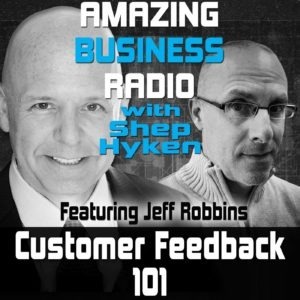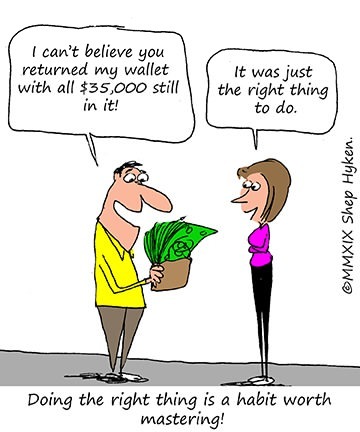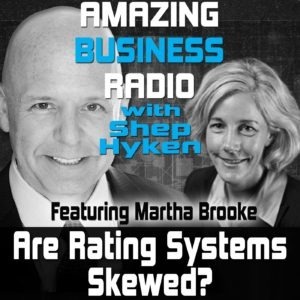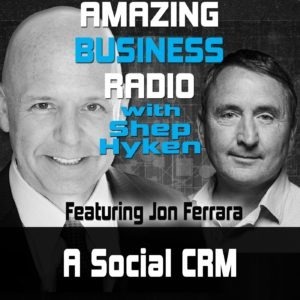Shep Hyken's Blog, page 131
February 27, 2019
Make Your Company’s Name Your Brand Promise
Earlier this year, I had the pleasure and honor of being the keynote presentation for River Valley Bank, soon to be Incredible Bank, as they merge the names of their brick-and-mortar banks and their online bank. I love that word, incredible, almost as much as my favorite word, amazing. If someone told you the customer service at a bank was incredible, you would only think positive things. What do they do that’s so incredible? I want to try some of what they call incredible.
What Incredible Bank is doing is interesting. They are putting it out there. Their name is a bold statement that is not just a name, but a brand promise. So as a customer, we will expect nothing less than an incredible customer experience. And those three words, incredible customer experience (what they refer to as I.C.E.), are the backbone of the name.
What a great mantra! For those that don’t know my definition of a customer service mantra, it’s a short sentence or phrase that summarizes the service vision. The three words that Incredible Bank has chosen is perfect for what they want their customers to experience. As Todd Nagel, president of the bank, says, “I.C.E. is how we do business; everywhere, every time.” It starts with each employee owning the moment, which means they recognize that every interaction with a customer is an opportunity for that customer to decide if the bank is delivering on the mantra and its brand promise. Every employee must own that responsibility.
How does Incredible Bank operationalize I.C.E.? They start with a playbook that lists the standards that drive the vision, which include something as simple as the proper way to greet customers as well as more detailed processes. As I read through the handbook, I could sense the bank’s vision and values coming through the pages. Ethics and behaviors are covered. Questions to trigger discussions and personal reflection are found throughout the book, implying that this isn’t just something to be read, but to be used. More than a playbook, this is a manifesto, a declaration of what they stand for.
So, if you were going to change the name of your organization to accurately describe what your customers would experience when they do business with you, what would that name be? What adjectives could you work into that name? I’m not suggesting that you change your name, as Incredible Bank has done, but it makes for an interesting conversation that will make you think about what you stand for when it comes to the amazing (or should I say incredible) service you want your customers to experience.
Shep Hyken is a customer service expert, keynote speaker, and New York Times bestselling business author. For information, contact 314-692-2200 or www.hyken.com. For information on The Customer Focus customer service training programs, go to www.thecustomerfocus.com. Follow on Twitter: @Hyken
customer service training programs, go to www.thecustomerfocus.com. Follow on Twitter: @Hyken
The post appeared first on Shep Hyken.
February 26, 2019
Amazing Business Radio: Jeff Robbins

Customer Feedback 101
Seeing Your Business Through the Eyes of the Customer
Shep Hyken interviews Jeff Robbins. They discuss the importance of customer feedback, the most effective surveys, and how to use these tools to create customer loyalty and improve your business.








In Shep’s Opening Monologue…
He discusses the best way to get customer feedback.
The Interview with Jeff Robbins:
Customers are better informed about both products and services than ever before thanks to the immediate availability of the internet.
Businesses need to check their online reviews often—at minimum, once a day. Negative reviews should be handled immediately. Ideally, positive reviews should also be responded to, as this shows customer appreciation.
Make it simple and easy for customers to give feedback on your business. Remind them after the service is completed and enable them to leave feedback.
As a general rule, surveys should be sent out to customers within 24 hours of their experience. This will vary by industry; test different intervals to see what nets you the highest response rate.
Keep surveys short and simple. People have less time to complete long questionnaires. A good format to consider is a single “yes or no” or an NPS or CSAT type of question followed by one open-ended follow up question.
Creating customer loyalty isn’t just about having a good product or a low price; it’s about creating a good customer experience. The experience can be what differentiates your business from others and keeps customers coming back time and time again.
Solicit feedback from customers in a way that makes them feel like you genuinely care about what they have to say. Their opinion matters; use it to ensure that your business goals align with the customer experience.
Quotes:
“It doesn’t matter how good you think the customer service is that you’re providing; it’s what’s perceived by your customers that counts.” – Jeff Robbins
“The customer is ultimately the judge and jury on the experience that you provide.” – Jeff Robbins
“The customer has the most important perspective on your business.” – Jeff Robbins
About:
Jeff Robbins is the Founder and Managing Director of Database Sciences and GuestInsight. He has over 30 years of experience in the marketing research and data management and analysis fields.
Shep Hyken is a customer service and experience expert, New York Times bestselling author, award-winning keynote speaker, and your host of Amazing Business Radio.
This episode of Amazing Business Radio with Shep Hyken answers the following questions … and more:
How do you create customer loyalty?
What’s the best survey question?
How can I get more customer feedback?
What should I do with a bad online review?
How can I make my business stand out?
The post Amazing Business Radio: Jeff Robbins appeared first on Shep Hyken.
February 25, 2019
5 Top Customer Service Articles for the Week of February 25, 2019
Each week I read a number of customer service and customer experience articles from various resources. Here are my top five picks from last week. I have added my comment about each article and would like to hear what you think too.
3 Lessons From a Customer Service Failure by Jill Schiefelbein
(Entrepreneur) Every brand touchpoint is important. Every interaction is a chance for your employees to communicate the experience that your brand provides.
My Comment: Jill Schiefelbein tells us a great story and shares three excellent customer experience lessons; the voice on the phone matters, industry jargon can create a barrier and kill an experience, and the process shouldn’t inconvenience the customer. A quick read with some important reminders.
Brand Keys 2019 Customer Loyalty Engagement Index: Verified Trust = Brand Success by Robert Passikoff
(CeoWorld Magazine) Brand Keys 24th annual Customer Loyalty Engagement Index® (CLEI), conducted by the New York-based brand engagement and customer loyalty research consultancy has definitively identified “loyalty” as a profit-generator for brands that know how to create it and market it.
My Comment: If you can’t create trust between your company and your customer, you are destined for failure. This article makes the point that trust is a defining piece of the customer experience. It drives repeat business and loyalty. It drives word-of-mouth referrals. Today’s customers expect trust, and as the author states, it “has become the indispensable connective tissue between brands and customer loyalty.”
How teaching your employees to provide great guest experiences increases sales by Alyssa Hanson
(Fast Casual) A restaurant’s strongest competitive differentiator is the experience they offer their guests. And considering the average lifespan of a restaurant is less than five years (90 percent fail within just one year of opening their doors), that experience can either make or break a restaurant’s chance of success.
My Comment: It doesn’t matter your type of business or industry, there is much to learn from the restaurant industry – even the fast-food/fast-casual restaurant industry. One of my favorite concepts is to treat the employee the way you want your customer treated – maybe better. Yet, consider that customers also care about the way a company treats its employees. For example, “87% of customers’ affinity toward Starbucks is driven by the way the company treats its employees.”
Build A 5-Star Customer Experience With Artificial Intelligence by Alston Ghafourifar and Michael Evans
(Forbes) Rapid technological advances have created opportunities for smaller companies to serve customers around the world and effectively compete with larger companies for new customers.
My Comment: Every day I read articles on AI. Some of them are very technical. Really, it’s quite simple. AI should augment the process and experience, not replace it. Here are several ways that AI is helping different companies in different industries create a better customer experience (CX).
Have Many B2B Companies Missed The Customer Experience Revolution? by Adrian Swinscoe
(Forbes) There is evidence that many B2B companies have still not grasped these fundamentals and the role they play in delivering a well-designed, consistent and connected customer experience.
My Comment: I’ve heard it too many times. CX is for retail brands, as in B2C. Smart companies in the B2B space recognize the importance of delivering a powerful CX. The author makes the point, that regardless of your industry, you can’t afford not to be addressing CX. It’s what can differentiate you from your competition. It’s what can keep you in business!
Shep Hyken is a customer service expert, professional speaker and New York Times bestselling business author. For information on The Customer Focus customer service training programs go to www.TheCustomerFocus.com. Follow on Twitter: @Hyken
customer service training programs go to www.TheCustomerFocus.com. Follow on Twitter: @Hyken
The post 5 Top Customer Service Articles for the Week of February 25, 2019 appeared first on Shep Hyken.
February 22, 2019
Guest Blog: How One Experience Started My CX Passion
This week we feature an article by Stacy Sherman who reminds us that brands must not compete on price alone and shares a great story to illustrate this point from Stacy’s Pita Chips. – Shep Hyken
My obsession for Customer Experience (CX) started when I received a package in the mail on a random afternoon. I was not anticipating the delivery of a large box with a label that said, “To Stacy, From Stacy.” Upon opening it, I read a note from the owner of Stacy’s Pita Chips explaining how she sent a variety of FREE bags to hundreds of Stacys throughout the United States who spell their name the same way she does. I happened to be a lucky recipient, as my close friend who spells her name as Stacey (with an “e”) did not receive a box.
To no surprise, this experience left a positive impression on me. I continue buying Stacy’s Chips and referring the products to everyone I know.
I share my story because it serves as a reminder that brands should not compete on price alone. While there may be an expense to implementing a campaign as extraordinary and creative as the Stacy’s Chips campaign, memorable experiences lead to increased customer loyalty and word of mouth benefits that often outweigh those costs.
Since my Stacy’s Chips incident, I have been fascinated by CX and continue to pay very close attention to how companies deliver unforgettable experiences to win over customer’s hearts – and wallets.
OTHER COMPANIES DELIVERING WOW MOMENTS:
Trader Joe’s is another great example of a company dedicated to delighting customers. People love the brand not just because the products are outstanding, but because their service is beyond exceptional. Whenever I am trying to find something in the store and ask employees for help, they walk me to the item I am searching for rather than sending me on my own scavenger hunt as other grocery stores do.
Trader Joe’s proactively offers customers samples of anything on the shelves to ensure people like the products before purchasing. It’s a great way to eliminate the chance of buyers remorse. Then again, Trader Joe’s returns policy is so good that customers would never regret purchasing anything from the store. They permit product returns with no questions asked, even without a receipt. I could write a book just about my Trader Joe’s customer experience! You can read more about return experiences and lessons about DoingCXRight.
DoubleTree Hotels is another customer-centric organization that models good CX. Many people choose to stay at DoubleTree Hotels simply because of the warm delicious chocolate chip cookie they receive at check-in. Think about that example for a moment. One small cookie has a significant impact on customer perceptions and preferences for an entire brand. It’s a brilliant onboarding experience. It’s also an easy to execute Wow Moment.
Co-working space, WeWork, delivers unexpected Wow Moments at the ideal time and place in the customer journey. This personal WeWork story created a new relationship directly because of their focus on customer satisfaction.
WHAT CAN YOU DO TO SURPRISE YOUR CUSTOMERS IN MEMORABLE WAYS?
I encourage you to think about the above examples and figure out how to delight your customers without using price as the differentiator. Have any brands left an impression on you that keeps you talking about the experience years later, like my Stacy’s Pita Chips story? I’d love to hear your examples. They provide great CX lessons!
 Stacy Sherman is a Customer Experience & Digital Marketing professional with a proven track record of increasing sales & loyalty at B2B & B2C companies of all sizes & budgets. She’s currently Director @ Schindler Elevator Corporation, where she oversees Voice of Customer initiatives, CX measurement, “close the loop” processes & employee engagement contributing to increased sales, call in reduction & improved NPS results. Stacy is a Founding CX Board Member and Advisor @ Rutgers University and Blogger: www.DoingCXRight.com
Stacy Sherman is a Customer Experience & Digital Marketing professional with a proven track record of increasing sales & loyalty at B2B & B2C companies of all sizes & budgets. She’s currently Director @ Schindler Elevator Corporation, where she oversees Voice of Customer initiatives, CX measurement, “close the loop” processes & employee engagement contributing to increased sales, call in reduction & improved NPS results. Stacy is a Founding CX Board Member and Advisor @ Rutgers University and Blogger: www.DoingCXRight.com
For more articles from Shep Hyken and his guest contributors go to customerserviceblog.com.
Read Shep’s latest Forbes article: AI: The Technology Penicillin Of The 21st Century
The post Guest Blog: How One Experience Started My CX Passion appeared first on Shep Hyken.
February 20, 2019
Doing the Right Thing: A Habit Worth Mastering
 When it comes to taking care of customers, sometimes people go a little further than expected. When asked why, they often say, “It was the right thing to do.” There’s no incentive other than the desire to care for someone else. In a sense, that is what customer service is about. While we may be paid to do a job, sometimes doing something that is not required – and therefore not expected – is what the next level of a good customer service experience is all about.
When it comes to taking care of customers, sometimes people go a little further than expected. When asked why, they often say, “It was the right thing to do.” There’s no incentive other than the desire to care for someone else. In a sense, that is what customer service is about. While we may be paid to do a job, sometimes doing something that is not required – and therefore not expected – is what the next level of a good customer service experience is all about.
I received a note from M. N. Rao, one of our subscribers to The Shepard Letter. He shared a story that perfectly makes this point. The short version is this:
On a recent trip to Dubai, Mr. Rao took a taxi to his client’s office. About an hour later, he realized he left his phone in the taxi. He didn’t have the driver’s information, so he borrowed a colleague’s phone to call his lost phone and hoped the driver would answer. Sure enough, he did. Mr. Rao explained what happened and an hour later the driver made his way back to the hotel where he had picked up Mr. Rao earlier that day. The driver dropped off the phone at the front desk. He didn’t ask for money even though he had to take time out of his day to return to the hotel. He didn’t leave a phone number or any other contact information. He just wanted to take care of his customer.
I often write about how sometimes problems or complaints aren’t our fault. That doesn’t mean we can’t step up and take care of our customers. When Mr. Rao left his phone in the taxi, it wasn’t like he could complain to someone about it. No, it was his fault. He could only hope that his phone would be returned. While the driver could have demanded to be paid money to take the phone back to the hotel, he didn’t. Yet he would have every right to do so. After all, it wasn’t his fault the customer left his phone in the car. And most reasonable people would expect to pay the driver something for his effort.
But not this time. The taxi driver didn’t ask for money. He even chose to remain anonymous. He did it simply because, in his mind, it was the right thing to do.
That’s what customer-focused people do. They do the “right thing.” They do it because helping a customer—or even a colleague at work—is what they like to do. It makes them feel good. It’s a mindset, and practicing it turns it into a habit. Doing the right thing makes you feel good. Try it. Make it a habit. It’s a habit worth mastering.
Shep Hyken is a customer service expert, keynote speaker, and New York Times bestselling business author. For information, contact 314-692-2200 or www.hyken.com. For information on The Customer Focus customer service training programs, go to www.thecustomerfocus.com. Follow on Twitter: @Hyken
customer service training programs, go to www.thecustomerfocus.com. Follow on Twitter: @Hyken
The post Doing the Right Thing: A Habit Worth Mastering appeared first on Shep Hyken.
February 19, 2019
Amazing Business Radio: Martha Brooke

Are Rating Systems Skewed?
How to Get the Most Out of Your Customer Feedback
Shep Hyken interviews Martha Brooke. They discuss common rating systems implemented by many companies, the faults and flaws of these systems, and ways to improve the feedback process overall.








In Shep’s Opening Monologue…
He talks about the best ways to handle negative online reviews.
The Interview with Martha Brooke:
The way many rating systems are designed makes it easy to skew results. Customers don’t give honest feedback out of fear of potential repercussions.
One reason customers give positive ratings after negative experiences is that they don’t want to feel like they’re punishing someone. However, being honest is more helpful because it improves the community. That is the benefit of deep altruism versus superficial altruism.
There is little tangible proof that reviews and ratings are anonymous, so customers may also fear repercussions from rated individuals or that it will be harder to do business with that company in the future.
People are inundated daily with requests for feedback. It becomes easier to leave a simple 5-star review rather than a negative one or no review at all.
Companies need to define what a 5-star rating means so that their customers are on the same page. People tend to look think of extremes when giving feedback, but what 5 stars means to one person may not be the same for another.
The ultimate goal is to get the feedback to accurately reflect the customer experience.
Quotes:
“There are fewer amazing companies than one would like. I think every company could be amazing, but certainly not every company is.” – Martha Brooke
“Customers don’t know what they don’t know.” – Martha Brooke
“Want great customer feedback? It starts with having really authentic conversations. Open-ended questions are where the gold lies.” – Martha Brooke
About:
Martha Brooke founded Interaction Metrics in 2004 with the mission of dramatically improving the customer experience. She is a Certified Customer Experience Professional (CCXP) and holds a Blackbelt in Six Sigma.
Shep Hyken is a customer service and experience expert, New York Times bestselling author, award-winning keynote speaker, and your host of Amazing Business Radio.
This episode of Amazing Business Radio with Shep Hyken answers the following questions … and more:
How should I handle negative online reviews?
Are rating systems skewed?
What are some effective rating systems?
How can I get a higher response rate from my customer surveys?
How can I get good customer feedback?
The post Amazing Business Radio: Martha Brooke appeared first on Shep Hyken.
February 18, 2019
5 Top Customer Service Articles for the Week of February 18, 2019
Each week I read a number of customer service and customer experience articles from various resources. Here are my top five picks from last week. I have added my comment about each article and would like to hear what you think too.
Top Technology Trends That Will Reshape The Customer Experience In 2019 by Puru Govind
(Forbes) As the CTO of a company that streamlines customer care operations, I’ve seen firsthand how fast access to products and services, combined with seamless processes without media disruptions and channel changes, is at the top of the list of priorities for customers.
My Comment: What does the future of CX look like? According to the author of this article, three big technologies will impact CX; conversational bots, the Internet of Things (IoT) and analytics through machine learning (AI). I agree that they are all getting better, and at a rapid pace. I’m looking forward to seeing how much better.
3 Customer Loyalty Trends for 2019 by SmarterCX Team
(SmarterCX) From the continued growth of ecommerce to the rise of experiential retail, 2018 saw a number of changes within the retail industry. And as retail trends continue to evolve in 2019, so do customer loyalty trends and programs.
My Comment: As long as we’re talking trends for the year, here are three trends that focus on loyalty programs. The one that intrigues me most is the first one, which covers how loyalty will have a focus on not just repeat visits and purchases, but advocacy. Are you willing to recommend the business to a friend? If so, you may be rewarded.
Pioneers: Who’s really going to drive a new retail perspective? by Mimi Lettunich
(Retail Customer Experience) With nearly 3.8 million retail establishments currently operating in the U.S. alone, today’s retail environment has never been more competitive.
My Comment: I found this article very interesting. It has several excellent examples of how companies (retailers) are taking advantage of in-store customer experiences and separating themselves from online competition. It’s hard to try out a bed on a website.
What is CX? The Experts Weigh In With 3 Ways to Conceptualize It by Erin Ollila
(SmarterCX) We asked three experts what they’d compare CX too, and here is what they said.
My Comment: What is CX? My basic definition is the end-to-end experience that the customer has with every interaction with anything related to the brand. That said, three experts share their takes; it’s like a party, it’s like a romance, and it’s like a well-oiled machine.
Customer Experience & Customer Service Stats from 2018 and Predictions for 2019 by Jake Michaels
(GreenRope) For our second post in the series of statistics, let’s talk customer service trends for 2018, and how companies are changing the way they manage their customer’s experience for 2019.
My Comment: There’s plenty of stats and facts to get you thinking in this article that recaps some findings from last year and predictions for this year.
Shep Hyken is a customer service expert, professional speaker and New York Times bestselling business author. For information on The Customer Focus customer service training programs go to www.TheCustomerFocus.com. Follow on Twitter: @Hyken
customer service training programs go to www.TheCustomerFocus.com. Follow on Twitter: @Hyken
The post 5 Top Customer Service Articles for the Week of February 18, 2019 appeared first on Shep Hyken.
February 15, 2019
Guest Blog: 5 Ways Your POS Will Empower Your Staff
This week we feature an article by Heather Hamilton who shares why investing in a point of sale (POS) system can empower your staff and improve the employee experience. – Shep Hyken
Investing in a point of sale (POS) system is a game changer for your retail business. From stock management to sales reports, customer loyalty, and much more, a POS system streamlines your efficiency in ways that pen and paper just can’t.
Something you should think about when shopping for a POS is how it’ll impact your staff’s performance. When your staff feels in control of the system they’re using, not only will they feel happier, but they’ll be more productive as a result.
Here are some of the ways the right POS can empower your staff.
It helps them personalize their service
Your staff can deliver a more personalized experience when they have more information about who they’re serving. 60% of consumers will pay more for a better experience, so it literally pays off. Look for these POS features that can help at the register:
Purchase history: Have you received new stock that a returning customer has bought before? Your staff can let them know about new arrivals they’re interested in
Customer groups: These help your staff identify your frequent buyers, VIPs, employee family members, etc., so they can provide that extra special service.
Customer notes: Even if your staff is in a hurry, they can easily make a personal connection with a quick glance at the notes added to a customer profile from a previous purchase. Things like proper name pronunciation (e.g. it’s E-LEE-NAH, not ELLE-N-AH), their pet’s name, favorite colors, you name it.
It helps them manage stock
Whether it’s doing inventory counts or simply looking up an item on behalf of a customer, your POS system should have strong inventory management capabilities. Not only do you want your staff to feel in control of what they’re doing, but you want features that make typically unpopular tasks much easier to perform.
Mobile app: Your staff never needs to abandon a customer by disappearing to the back room to look for an item — they can search for inventory on a mobile device with just a few taps. It also makes inventory counts pretty painless when you can walk around your store with a tablet, versus running back and forth to your desktop computer.
Work orders: Work orders should be easy to find and clearly identified in your system. If a customer comes in to pay for an item that’s in your shop for a repair or other service, you don’t want them to wait forever while your staff scrambles through endless paperwork to find what they came in for. Similarly, your staff should always know which items in the system are available to sell and which ones are reserved for other customers.
It makes checkout faster
During busy periods like the holiday season, your staff is under a lot of pressure to process sales fast. Customers hate waiting in line, but, with flexible payment options, there’s no need for your staff to panic.
Mobile payments: Once again the mobile app comes in handy! A tablet makes for a great line buster during busy periods. Ring up a customer from anywhere in your shop.

Integrated payments: We can’t say enough about the benefits of using a POS with integrated payments. Non-integrated payments mean your team needs to punch in the amounts manually, which makes each transaction a little slower and makes room for lots of errors and lost revenue. It also takes longer to close out for the day. All this to say, use integrated payments for a faster sales process and end-of-day close.
It helps with performance reviews
Employee recognition is really important, but it’s tough to accurately evaluate your employees without any numbers to support your feedback. Reports in your POS help you see who your top performers are so you can recognize their hard work and reward them accordingly. Likewise, it’s also easier for you to identify who on your team needs more training or encouragement. When you’ve got numbers to share during your performance reviews, it’s not only easier for you to give feedback, it gives your team actionable goals when it comes to improvement.
It’s easy for them to use
Whether it’s managers, full-time staff, or seasonal employees, you want software that’s intuitive and doesn’t take long to learn the basics. You also want a company that offers 24-7 tech support for those times when you run into a snag. Tech rage is a real thing, so do your staff a solid and invest in technology that won’t make them want to tear their hair out.
When it comes to choosing the right point of sale, think about the daily grind. Talk to your staff to get their perspective, or, better yet, take advantage of a free trial so they can test it out themselves.
Heather Hamilton writes content for Lightspeed POS to help retailers stay competitive and improve the way they run their business. Outside of work, she can usually be found wandering around Montreal neighborhood in search of food.
For more articles from Shep Hyken and his guest contributors go to customerserviceblog.com.
Read Shep’s latest Forbes article: Keep Your Employees And You’ll Keep Your Customers
The post Guest Blog: 5 Ways Your POS Will Empower Your Staff appeared first on Shep Hyken.
February 13, 2019
Five Ways to Say Thank You to Your Customers
 Valentine’s Day is tomorrow. This is the day where we send our spouses, partners, and loved ones a gift. Often it is out of obligation. I have plenty of friends who tell me if they don’t get their spouse some flowers and a card, they will pay for it. So we feel obligated to express our love and appreciation to those close to us. I’ve written several articles about this before, and my favorite one is called The Valentine Obligation. You don’t have to send your customer flowers, but how about an expression of appreciation? It can be something as simple as a thank you note or as elaborate as a customer appreciation event. And you don’t have to send it on Valentine’s Day. Any day is a good day to show some customer love. With that in mind, here are five ways to say thank you to your customers.
Valentine’s Day is tomorrow. This is the day where we send our spouses, partners, and loved ones a gift. Often it is out of obligation. I have plenty of friends who tell me if they don’t get their spouse some flowers and a card, they will pay for it. So we feel obligated to express our love and appreciation to those close to us. I’ve written several articles about this before, and my favorite one is called The Valentine Obligation. You don’t have to send your customer flowers, but how about an expression of appreciation? It can be something as simple as a thank you note or as elaborate as a customer appreciation event. And you don’t have to send it on Valentine’s Day. Any day is a good day to show some customer love. With that in mind, here are five ways to say thank you to your customers.
A thank you note: Call me old fashioned, but the traditional hand-written thank you note still has power. Of course, you can consider an email or text message. But which one do you think has the most impact? For those of you who think this is a rhetorical question, here’s the answer: the old-fashioned hand-written note.
A thank you video: If you send a short, personalized video – even something as simple as from your mobile phone – you’ll make the point. I actually think this is almost as strong a hand-written note. The key is that it must be personalized.
A charitable contribution: This a great gesture of appreciation, and if the charity you contribute to is one that your customer contributes to, then you’ve hit a personal note that will be remembered and appreciated.
Send a thoughtful gift: By a thoughtful gift, I mean one that is very personalized. It should be obvious that you put thought into it. One of my favorite gifts I ever gave was a book by a friend’s favorite author. But not just any book. I found a first edition autographed copy of the book. He loved it and it has a permanent place on his bookshelf. And he’ll always remember who gave it to him.
A customer appreciation event: These can be fun yet also expensive. And if you have a national or international customer base, it won’t be practical. So, let’s modernize this and do a customer appreciation Facebook Live event. This could be a fun way of expressing appreciation, and at the same time, the rest of the world gets to see how much you love your customers.
As I created this list, I came up with many more ways to say thank you. However, this isn’t meant to be the definitive work on appreciation—just something to get you to start thinking about it. And, as long as I have your attention, THANK YOU for reading!
Shep Hyken is a customer service expert, keynote speaker, and New York Times bestselling business author. For information, contact 314-692-2200 or www.hyken.com. For information on The Customer Focus customer service training programs, go to www.thecustomerfocus.com. Follow on Twitter: @Hyken
customer service training programs, go to www.thecustomerfocus.com. Follow on Twitter: @Hyken
The post Five Ways to Say Thank You to Your Customers appeared first on Shep Hyken.
February 12, 2019
Amazing Business Radio Jon Ferrara

A Social CRM
Growing Your Business by Growing Your Soul
Shep Hyken interviews Jon Ferrara. They discuss his company Nimble, the history of CRMs, customer service philosophies, and life.








In Shep’s Opening Monologue…
He considers the balance between the digital and the human experience in customer service.
The Interview with Jon Ferrara:
Jon Ferrara created GoldMine, the pioneer CRM program, by synthesizing existing technologies at the time. His goal was to make it easy for companies to manage not only their customers, but their team collaboration and relationships.
Previously, less than 1% of companies used CRMs because they focused more on reporting data rather than the relationships between employees and customers.
Good customer service begins from the inside; employees need to be unified in their mission to enhance the customer’s journey.
CRM’s help you create positive personal connections, which can only have a positive affect your business.
Ask yourself how you can add value to every interaction you have with a customer or an employee, even if it’s as simple as a smile. That attention and focus will help grow your business and fulfill you personally.
Quotes:
“We grow by helping other people grow.” – Jon Ferrara
“A brand is built on the promises you make and the experience that you deliver. People don’t buy great products, they buy better versions of themselves.” – Jon Ferrara
“Service is the new sales.” – Jon Ferrara
“When it comes to relationships, people connect on the five Fs of life: family, friends, food, fun, and fellowship.” – Jon Ferrara
“Life is like a Beethoven symphony. There’s high and there’s low notes, and you have to accept both.” – Jon Ferrara
About:
Jon Ferrara is the founder and CEO of Nimble and a CRM expert, having created and co-founded GoldMine. He is also a technology entrepreneur and noted speaker about Social Sales and Marketing.
Shep Hyken is a customer service and experience expert, New York Times bestselling author, award-winning keynote speaker, and your host of Amazing Business Radio.
This episode of Amazing Business Radio with Shep Hyken answers the following questions … and more:
How can companies best utilize digital customer service technologies?
What is the history of CRM software?
What are some philosophies behind customer service?
How does the customer experience start from the inside out?
How does emotion affect the success of a business?
The post Amazing Business Radio Jon Ferrara appeared first on Shep Hyken.



